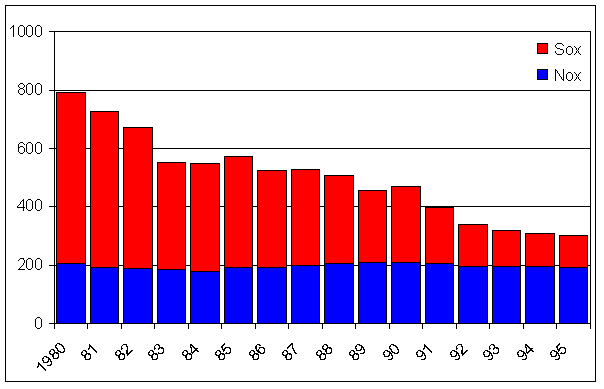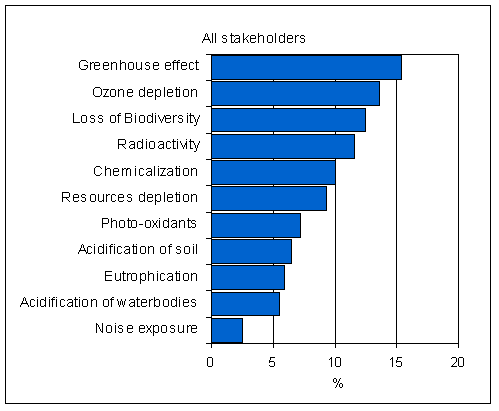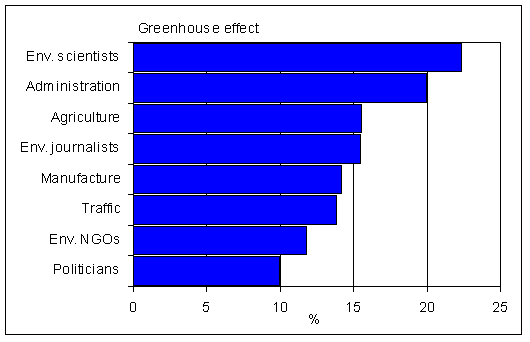|
|
|
|
Index of Environmental FriendlinessExecutive summaryThe purpose of this methodology research is 1) to develop a model for the evaluation of environmental friendliness in order to create new and more diversified information on environmental issues and 2) to assess the suitability and development needs of current databases as well as engineering data for comprehensive assessments. The introduction provides the context for the development of aggregation methodologies for the production of new information categories for decision-making and environmental communication and discussion. The model description provides a short overview of the framework designed for the model and principles applied in the data processing of environmental data and valuation of environmental concerns. The model evaluation presents the main results of the study and the section on conclusions an analysis of the state of the art after the study, as well as future work areas. IntroductionThe need for aggregated environmental information has become a concrete goal of nations committed to contributing to sustainable development and to the establishment of an integrated economic and environmental information system for the sustainability assessments. In recent years, international development work has focused on the development of environmental indicators. However, it has also been foreseeable that further aggregation of indicators to environmental indices could provide a chance for new policy guiding instruments and better integration of environmental and economic decision-making, as well as enchantced public participation in environmental discussion. Although the common principle to aggregate environmental data for problem assessments has gained international acceptance, it has also become evident that methods for the aggregation of pressure data are either not sufficiently well-established yet, or are under development, or are not available with respect to all environmental concerns. In addition, those that are available will impose, in the near future, considerable requirements for data production. As the credibility of aggregation methodologies is of crucial importance for the quality of new information categories, more research is needed on the aggregation methodologies and on the relevance of basic data for comprehensive assessments. Model for the Index of Environmental FriendlinessThe model for the Index of Environmental Friendliness is a general model for the aggregation of direct and indirect pressure data to problem indices and further to an overall Index of Environmental Friendliness. Both of these procedures are also included in the current NAMEA framework for environmental accounting. The approach is also applicable to the life-cycle assessments of products and production. The core assumption of the model is that environmental problems are the most feasible basis for a comprehensive assessment. Therefore the scope of the model is designed to cover the key environmental problems of greenhouse effect, ozone depletion, acidification, eutrophication, ecotoxicological effect, resource depletion, photo-oxidation, biodiversity, radiation and noise. However, it should be noted that the application of the model on a wide European scale would require expansion into problems such as salination and erosion. The aggregation of pressure data to problem indices calls for knowledge of impact pathways and pressures affecting the development of each environmental problem. In order to prevent overlaps in impact assessments of various concerns, the pressures are made commensurate with each other according to their primary impact potential. Evaluation of the primary impacts also responds to the information needs of environmental decision-making. The aggregation of pressure data proceeds step-wise
As the model gathers both direct and total pressures of economic activities, the assessment of environmental pressures proceeds parallel with both of them. This also provides a more complete picture of environmental impacts associated with each economic activity. In addition, it makes internal services and treatment operations comparable to those of purchased ones from the environmental point of view. The model provides information categories that can be used separately as such or together with relevant socio-economic data. In order to distinguish and recognize new development needs of data production, the practical testing of the model focuses on the identification of critical points of data aggregation and data characteristics as well as on the contents of current statistical and administrative databases. Since the most comprehensive data on environmental pressures available on manufacturing and related industries was for the year 1992, the testing of the model was done with this data. However, it should be borne in mind that the situation has changed since 1992 and the actual figures in this report should not be taken as indicative of the current situation. Due to shortcomings in either the aggregation methodologies or data availability, the practical testing of the model takes place with respect to the greenhouse effect, ozone depletion, acidification, eutrophication, ecotoxicological effect and resource depletion. Also the most important indirect emissions of electricity and heat consumption, waste and waste water treatment were attributed to the data evaluation in proportion to their purchases. Regarding the valuation of environmental concerns, a comprehensive pilot study on societal preferences was conducted in Finland. The valuation of environmental concerns is done by representatives of the stakeholders of environmental decision-making. The pair-wise comparison method is used for the valuation study and the results are analysed with the analytical hierarchical process (AHP). Figure 1. Index of Environmental FriendlinessModel evaluationGeneral resultsThe environmental problem-oriented aggregation method proved to be applicable for the formation of problem indices and the overall Index of Environmental Friendliness to be used both as such or in the NAMEA Environmental Accounting referred to in (COM(94) 670 final). Nevertheless, the minimisation of the overlap of problem definitions in various steps of data aggregation and evaluation is considered to be essential for the relevance of the quality of the Index of Environmental Friendliness. Therefore a further in-depth evaluation of aggregation methodologies of pressure data to Problem Indices, except for the greenhouse effect, was deemed necessary in the near future. A better understanding of the valuations of environmental concerns also calls for further research on methodologies, and the basis and scope of the valuation of environmental concerns. The need for a considerable improvement of current data production on environmental pressures will be essential for the model as well as for any other comprehensive environmental assessment. Furthermore, the integration of environmental and economic questions calls for systematic data structuring according to economic activities. Needs for data improvements relate especially to biodiversity, harmful substances, waste materials and photo-oxidant formation. In addition, further development is necessary with respect to environmental characteristics of purchased raw materials in order to expand the scope of indirect emissions to a complete picture of associated emissions. More detailed results are presented below. Pressure data on manufacturing and related industriesDatabase structuring
Equivalency factorsScientific agreement on the basis for the equivalency of pressure data to problem-specific indices varies from one problem to another:
Accordingly, the current data sources for impact evaluation do not facilitate a complete system for the assessment of environmental friendliness. Problem IndicesProblem Indices provide information on the joint potential impact of various pressures to a given environmental problem. Due to the wide, hardly controllable dispersion of pressures into the environment, no assessment of spatial variation of actual impacts were attached to the model. The Problem Indices provided by the model for the Index of Environmental Friendliness are applicable to the NAMEA Environmental Accounting. Problem Indices provide an opportunity to assess in which economic activities direct pressures and in which activities total pressures mostly affect each environmental problem. In addition, they enable a the creation of time-series analysis of the overall development of each environmental problem and the importance of individual pressure affecting the problem (Fig.1). Figure 2. Acidification index, SO2- and NO2-emissions in SO2-equivalents in 1980-1995 The aggregation methods and current data on pressures enable the calculation of economic activity-specific problem indices to be made on
There are some pressures whose impact is divided into several problem fields. The NOx emissions affect acidification (release of H+), eutrophication (release of N) and photo-oxidation (formation of PAN of NOx together with O3). Thus, the impacts of waste cannot be assessed on the basis of disposed waste amounts, but rather according to problem-specific impacts. Consequently, discarded waste ought to be included in the problem evaluations of:
These results are especially important with respect to the developments of the applications of the Index of Environmental Friendliness for the NAMEA Environmental Accounting. Valuation of environmental concernsThe valuation of environmental concerns seeks societal priority-setting for problems that cannot be ranked on the basis of their various impacts on the environment. Valuation combines common concerns attached to the characteristics and risks of environmental problems, their spatial scale (global, regional, local), expected development trends and their possible ecological and socio-economic losses or distortions. For the purposes of the model for the Index of Environmental Friendliness, numeric weighting factors are needed for the aggregation of normalised problem indices. The valuation of environmental concerns in Finland was carried out in the summer of 1995 with a pair-wise comparison method and by eight stakeholders. The stakeholders considered to be closest to the evaluation and communication of environmental problems were selected for the study. Agriculture, industry, transport and NGOs represent actors in environmental utilisation, while those of the administration and environmental politicians represent caretakers while those of the environmental media and research represent information producers on the environmental issues. Figure 3. Valuation of environmental concerns: all groups The most important environmental problems were considered to be the greenhouse effect, ozone depletion, loss of biodiversity and radioactivity (Fig. 2). The impact of the societal preferences seem to allocate to problems of a global and European scale, while the lowest scores were given to local problems such as noise. Unexpectedly, the development trends of problems did not correlate with the seriousness of the problem concerned, but rather to the overall characteristics of each environmental problem. The range of valuations varied considerably within and between stakeholders as well as with respect to the environmental problems (Fig. 3). The results of the valuation study indicate that the losses associated to various problems were in general either ecological or health ones, seldom economic or cultural ones. Stakeholder-specific interests did not seem to dominate the valuation of concerns. On the contrary, stakeholders were very conscious of their `own' problems; for example the scoring of noise was highest among the representatives of transport. Figure 4. Valuation of the greenhouse effect by stakeholders The results of the valuation of environmental concerns may be interpreted in various ways. One reason for a rather uniform, non-group-specific scoring might be the fact that the problem level could be a more neutral evaluation level than that of various pressures. In addition, it might also indicate difficulties in the distinction of the seriousness of various key environmental problems. On the other hand, the rather uniform result might to some extent be due to the method selected as pair-wise comparisons of the Analytical Hierarchical Process are designed in such a way that the most serious problem could be, at the maximum, nine times more serious than the least serious problem. Regarding the highlights received from the valuation study, an in-depth study of the pros and cons of the various methods available as well as the possibilities to use a combination of methods, for instance the AHP and Delphi methods, would be a necessity. The choice of research method greatly affects the scale of the mutual weighting of problems as well as the applicability of the results to the formation of the Index of Environmental Friendliness. Nevertheless, it should be also noted that systematic and regular studies on the valuation of environmental concerns are feasible for environmental decision-making as such as well as for the aggregation of environmental data. In addition, it should be borne in mind that data on problems such as biodiversity, radiation, ecotoxicological effect, resource depletion and photo-oxidation is insufficient. Index of Environmental FriendlinessThe Index of Environmental Friendliness combines ecological information on problem-specific impacts and societal valuation, thus providing a comprehensive assessment of each economic activity. The separate aggregation of pressures to problem indices and the subjective valuation of environmental concerns makes the model steps more transparent and applicable for various users. However, it is worth remembering that the applicability of the index for comprehensive assessments is greatly dependent on the representativeness of the set of problems selected for the index. Consequently, this requires that
The threat of overlaps in the problem evaluation first appears in the aggregation of pressures to problem indices and secondly in the relative valuation of environmental concerns. In the former, the restriction of problem assessment to the primary impacts only provides a clear distinction between key problems. In the latter, the persuasion of respondents to restrict the assessment of the seriousness of problems to the primary impacts is difficult, but necessary for the overall representativeness of the results. When using the AHP method and pair-wise comparision of problems in the valuation study, it would be better to include problems of minor importance to the set of problems than to leave them out. However, the selection of problems may affect the suitability of the valuation method to be used. The valuation of environmental concerns combines the state of environment assessment and long-term risk expectations associated with key environmental problem. The combination of the two might lead for instance to a situation where small, but cumulative pressures (of for example ozone depleting substances) receive very strong weights in the valuation when the long-term impacts are considered to be very serious ones. On the other hand, some problems such as eutrophication receive lower weights in the valuation possible due to the necessary protective measures are known and have already been taken care of in certain extent. Thus, the main advantage of the overall Index of Environmental Friendliness relates to the comprehensive and somewhat future-oriented assessment of environmental problems in each economic activity. The application of similar data structuring to that of the national accounting system enables an integrated evaluation to be made of environmental and economic questions in macroeconomic assessments such as in the NAMEA Environmental Accounting. This can take place in a joint matrix of economic activity profiles together with various information levels produced in the index formation for example pressure and problem profiles. Due to shortcomings in both the data on pressure and in impact assessment (equivalency factors), no overall Index of Environmental Friendliness can be constructed in Finland at present. In the most optimal case, a comprehensive assessment of the best known problem fields of the greenhouse effect, ozone depletion, acidification and eutrophication at the national level would represent less than half of the valuations given to the key environmental problems. The core nature of the problem-orientation in the model for the Index of Environmental Friendliness emphasizes the need for a fixed set of key environmental problems to be investigated with respect to their societal importance. A fixed set provides good representativeness for time-series and good comparability for various studies or applications both at the national and at the European level. Although the European set of problems might be wider (including possibly such problems as salination, erosion), the national weighting factors for each problem ought to rely on national results also in the European study on valuation. ConclusionsThe overall model evaluation reveals that the selected approach and methodology are feasible with respect to current information needs. The problem-orientation is widely used in the aggregation methodologies, although there are still environmental problem fields where international consensus has not been reached for environmental impact assessments. The model for the Index of Environmental Friendliness compresses detailed pressure data into a number of new information categories, which facilitate a more diversified analysis of the current situation as well as of development trends. The model translates basic pressure data into Problem Indices describing potential joint impacts of pressure and combines the indices with numeric data on the societal preferences of environmental concerns in order to provide an overall Index of Environmental Friendliness. Thus, large numbers of parameters are aggregated in order to compress information into a reduced number of parameters and provide problem-oriented information for decision-making. The new information categories produced by the model for the Index of Environmental Friendliness can be used separately from each other, together with economic and social data or as a part of the Index of Environmental Friendliness. The Index of Environmental Friendliness is also directly applicable to the NAMEA Environmental Accounting. Consequently, the model provides effective means for processing information into integrated assessments of sustainability. As regards the quality of the information provided with the model, this is naturally very dependent on the quality of the basic pressure data, and research data on impact pathways and methods used in studies on the valuation of environmental concerns. For the moment, the Problem Indices produced by the model are of the best information quality. Consequently they could be used in publications especially desingned for political decision-making. One of the most important ones in Finland is the Environmental Data Compendium as well as Natural resources and the Environment, as well as in the forthcoming NAMEA Environmental Accounting - a system aimed at an integrated environmental and economic accounting. Further development of the model itself would be necessary with respect to impact assessment of selected problems such as biodiversity, radiation, resource depletion, ecotoxicological effects, (terrestial) eutrophication and photo-oxidation. In addition, more in-depth studies will be necessary on the methods to be applied in the studies on the valuation of environmental concerns. Also a fixed European set of key environmental problems needs to be defined in order to provide comparable international data of respective studies in the future. The valuation of environmental concerns calls for further methodological development both in terms of valuation methods and in terms of the societal representativeness. The methodological development needs relate to the in-depth assessment of the pros and cons of existing methods. The representativeness of the valuation results ought to be guaranted by a selection of the most relevant stakeholders and their representativeness in the valuation exercise. Also the need for an expert selection procedure similar to the one applied in the Eurostat Pressure Index project should be assessed in detail. The number of representatives ought to be considered also with respect to restrictions set by the statistical methods used for the analysis of results. As the model for the Index of Environmental Friendliness is a comprehensive model for data aggregation, considerable demands for data improvements were found in the model evaluation. The most crucial ones relate to the calculation of basic pressure data and to scientific, pressure-specific data on environmental impacts. As the data on manufacturing and related industries in Finland are the most comprehensive, there is inevitably a great demand for the overall evaluation of pressure data itself as well as for the priority settings of data production responding to current and long-term data needs. Future workThe model for the Index of Environmental Friendliness reveals development needs for environmental data and for valuation methods. The emphasis of future work ought to focus on the following subject matter fields: A) Development of data production with respect especially to the
B) Development of the model approach with respect to
C) Utilisation of the information categories provided with the model in the following product development
Author: Marianne Kaplas (leave of absence) Contact information: Leo Kolttola Tel: +358 9 1734 3234 E-mail: ymparisto.energia@stat.fi
Home Page of Environment and Energy |



